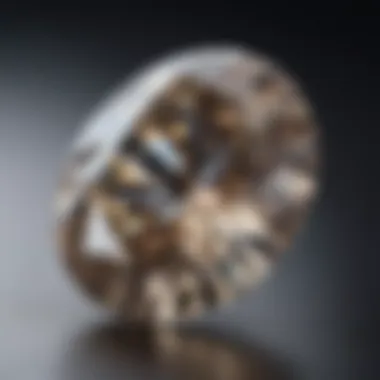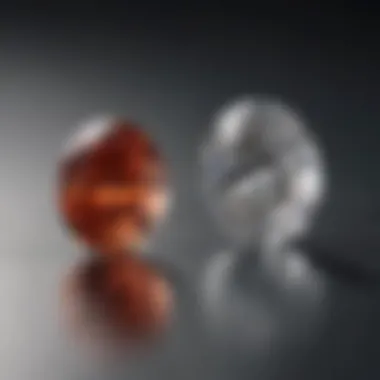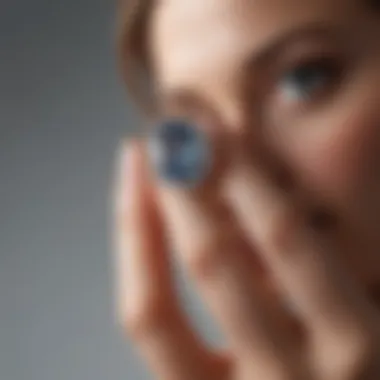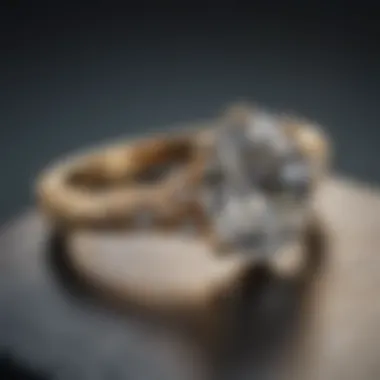Understanding Oval Diamond Size on Hand: A Comprehensive Guide


Intro
The selection of an oval diamond can be a nuanced decision for many. Far from being simply a matter of size, the way an oval diamond appears on the hand is influenced by several factors. Understanding these factors can greatly enhance the purchasing and wearing experience. This article aims to dissect these elements to offer insights into oval diamond size and its presentation on the hand.
Preamble to Oval Diamonds
The allure of oval diamonds lies in their unique shape and elegant appearance. This introduction is essential for those exploring oval diamonds, particularly in the context of how they look when worn. Understanding oval diamonds can help buyers make informed decisions, especially when considering factors that influence perceived size.
Definition of Oval Diamonds
Oval diamonds are shaped like elongated rounds, featuring a symmetrical outline that creates a sophisticated silhouette. The design combines the classic appeal of round diamonds with a modern twist, making it versatile for various settings. Their dimensions typically include an average width-to-length ratio of 1.33 to 1.66, contributing to their distinctive look.
Popularity of Oval Diamonds
The popularity of oval diamonds has surged in recent years. Many celebrities have chosen them for engagement rings, further influencing public interest. Buyers are drawn to the oval shape for several reasons.
- Illusion of Size: Oval diamonds tend to appear larger than their carat weight due to their elongated shape. This visual effect appeals to many individuals seeking a luxurious look without the higher price tag of larger stones.
- Versatility: Oval diamonds complement various styles of jewelry, from contemporary to vintage settings. They can enhance subtle designs or make bold statements in more elaborate settings.
- Unique Aesthetic: The distinctive shape stands out among traditional round diamonds. This individuality is appealing to those wanting something special and different.
The growing interest in oval diamonds spotlights a shift in consumer preferences, reflecting a desire for both elegance and uniqueness in jewelry choices.
Factors Affecting Diamond Size Perception
Understanding how oval diamond size is perceived is essential for both buyers and enthusiasts. Several elements influence this perception, thus playing a significant role in how these stones are valued and chosen. Factors like cut, clarity, color, and setting work together to shape our understanding of size. Knowledge of these factors can help buyers make informed decisions when selecting an oval diamond. It’s not merely about the carat weight; the visual impression is equally important.
Cut and Proportions
The cut of an oval diamond is perhaps the most crucial factor affecting its perceived size. The brilliance and fire of the diamond depend directly on how well it has been cut. A well-cut oval diamond can reflect light beautifully, making it seem larger than it actually is. Proportions also matter significantly. A longer and narrower shape often appears larger than a wider oval of the same carat weight. Buyers should pay close attention to the length-to-width ratio, aiming for a ratio between 1.33 and 1.5 for an aesthetically pleasing appearance. Consequently, investing in a quality cut can enhance the overall appeal of the diamond.
Clarity and Color
The clarity of an oval diamond directly affects its visual perception of size. Diamonds that have fewer inclusions and blemishes appear larger, as clear stones reflect more light neatly. Also, the color plays a role; a colorless diamond often looks more prominent than a tinted one. This is because colorless stones can reflect light more effectively, adding to the visual size. The GIA color scale, which ranges from D (colorless) to Z (light yellow), should be a reference point when buying. Opting for higher clarity and color grades enhances the diamond’s brilliance, making it look larger than lower-grade alternatives.
Setting Styles
The style of the setting can significantly influence the size perception of an oval diamond. A setting with minimal metal and intricate designs can make the diamond stand out more, thus appearing larger. For instance, a solitaire setting emphasizes the diamond itself, while a halo setting, which surrounds the center diamond with smaller stones, can create an illusion of increased size. Additionally, the choice of metals such as white gold or platinum can produce a contrast that makes the diamond appear more vivid and prominent against the skin. Therefore, selecting the right setting is as vital as choosing the diamond itself.
Comparative Analysis of Diamond Shapes
Understanding the differences between various diamond shapes is crucial for those considering the purchase or evaluation of oval diamonds. This comparative analysis allows buyers to appreciate unique characteristics, which can shape their preferences and decisions. When one understands how oval diamonds stack up against their round counterparts and other fancy shapes, it provides clarity on aesthetic appeal and value.
Oval vs. Round Diamonds
Oval diamonds, while sharing some similarities with round diamonds, have distinct differences that can influence a buyer's choice. The most notable distinction is in shape – ovals feature an elongated body that can create an illusion of size, making them appear larger than their carat weight suggests. In contrast, round diamonds, having more symmetrical facets, reflect light in a different manner, producing a classic brilliance and radiance.


Benefits of Choosing Oval Diamonds:
- Appearance of Size: The elongated shape of the oval can visually enhance the size of the diamond.
- Unique Look: Oval diamonds stand out due to their rare form, making them a good choice for those seeking an alternative to the traditional round shape.
- Play of Light: The oval's facets can produce a unique dance of light, distinguishing it from conventional shapes.
However, round diamonds tend to have superior sparkle due to their precise cut, which maximizes brightness and fire. This makes them inherently more permanent in popularity among consumers. When contemplating whether to choose an oval or round diamond, it is essential to assess not just the visual aspects but also the emotional resonance each shape embodies.
Oval vs. Other Fancy Shapes
When comparing oval diamonds to other fancy shapes such as pear, marquise, or princess, distinct qualities emerge. Many fancy cuts, including the pear and marquise, also emphasize length and shape similar to ovals, but each brings its unique set of advantages.
Key Points of Comparison:
- Shape Variety: Fancy shapes, which include oval, often allow for personal expression. Each shape can convey different moods and characteristics.
- Light Reflection: Not all shapes perform the same under light. Ovals tend to excel in offering more noticeable size while still reflecting a good amount of light, though less than round shapes.
- Setting Versatility: Oval diamonds can be paired exceedingly well with various settings, often harmonizing nicely with both classic and modern designs.
Each fancy shape, including ovals, has its own following. Taking time to explore and compare these shapes will lead to a more informed decision, especially given factors such as personal style and hand dimensions. Buyers should also consider how different settings can enhance the beauty of each diamond shape, aligning with their personal aesthetics and lifestyle.
Impact of Hand and Finger Size
The role of hand and finger size in determining how oval diamonds appear on the hand cannot be overstated. Understanding this relationship is essential for anyone interested in jewelry, particularly for prospective buyers and enthusiasts. The visual perception of a diamond is not solely dependent on its carat weight or cut; rather, it is significantly influenced by the context in which the diamond is presented. Finger and hand dimensions contribute to the overall look, altering the perceived size and elegance of the ring.
When selecting an oval diamond, potential buyers must be aware of how their individual hand characteristics can affect the ring's appearance. This consideration helps in making more informed choices that complement personal style and enhance overall aesthetic appeal.
Finger Width and Diamond Size Relationship
Finger width plays a crucial role in how an oval diamond is perceived. A wider finger can make smaller diamonds appear more petite, whereas on a slender finger, a diamond may look more substantial than it actually is. This discrepancy can create an illusion that affects buyer preferences.
To appreciate this relationship better, consider the following points:
- Visual Balance: A diamond's size needs to correlate with the finger's width for balance. A very large oval diamond on a narrow finger may create a look that feels disproportionate.
- Design Considerations: When choosing a setting for the diamond, factors like prong style and width of the band are also influenced by the finger's width. Narrow bands may suit slender fingers, while wider bands may work better for larger fingers.
- Custom Sizing: It’s worth noting that some customization can enhance how the diamond looks on a specific finger. Custom settings can be designed to create the desired visual impact.
This awareness around finger width empowers buyers to make selections that appear harmonious rather than mismatched.
Hand Shape Considerations
Hand shape encompasses factors like the length of fingers, the prominence of knuckles, and general proportions. Each of these elements can dramatically influence the overall presentation of an oval diamond. A diamond that complements the hand's shape can enhance the aesthetic appeal of the piece.
Several considerations are notable:
- Long vs. Short Fingers: Long fingers can carry larger diamonds without appearing overwhelmed. Conversely, shorter fingers may benefit from smaller diamonds that do not visually elongate the hand.
- Knuckle Size: Prominent knuckles might require a different approach in ring design. An oval diamond that is set lower may appear elegant and not draw attention away from the knuckles.
- Overall Proportions: A diamond's ratio must be in sync with the hand's proportions. An oval diamond's length-to-width ratio affects how it looks against the hand, making this characteristic vital for choosing the right ring.
Incorporating an understanding of hand shape can help create a more flattering and attractive look for the ring wearer. This way, buyers can ensure they choose an oval diamond that suits their unique hand structure and preferences.
Visual Perception of Oval Diamonds
Understanding how oval diamonds are perceived visually is essential in appreciating their beauty and making informed purchasing decisions. The unique characteristics of an oval diamond can create specific visual effects that may enhance or detract from its overall size appearance. Factors such as optical illusions and the way light interacts with the gem play a pivotal role in how a diamond is seen, especially when set on a hand. This section will explore these elements in detail, helping potential buyers to grasp the nuances of oval diamond presentation and selection.


Optical Illusions and Diamond Size
The perception of an oval diamond's size is often influenced by optical illusions. Oval diamonds, due to their elongated shape, can appear larger than their actual carat weight. This visual impact arises from the diamond's proportions. A well-cut oval with an optimal length-to-width ratio can create an effect of greater size. The cut, therefore, becomes crucial in maximizing this illusion. Additionally, the way light reflects off the facets can create a sparkle that captures attention, further contributing to perceived size.
Some buyers may mistakenly equate size with carat weight alone, overlooking how shape and setting affect this perception. For instance, when placed in a wide band or a halo setting, an oval diamond's length can create an optical illusion of added size. A careful consideration of these settings and proportions is necessary when wishing to optimize the aesthetic appeal of the oval diamond.
"The beauty of an oval diamond lies not just in its size, but in the harmony it creates with the hand."
Color and Light Reflection
Color and light play an integral part in the visual perception of oval diamonds. The way a diamond reflects and refracts light significantly influences how it is viewed. Oval diamonds, with their multi-faceted cut, can exhibit a brilliant display of colors when viewed from different angles. This interplay of light can sometimes make a diamond look larger or more vibrant than it actually is.
Furthermore, the diamond's color grade can affect perception as well. A diamond with a higher clarity and color grade will reflect light more efficiently, enhancing its sparkle, and thereby its perceived size. Consider choosing an oval diamond that balances both clarity and color. In doing so, buyers can maximize visual impact.
In summary, oval diamonds possess unique attributes that affect how they are seen visually. Understanding these aspects allows buyers to make educated decisions when selecting the right diamond for their personal style and preference. Paying careful attention to optical illusions and the impact of color and light can guide buyers in choosing an oval diamond that not only meets their specifications but exceeds their expectations.
Sizing Considerations Before Purchase
Understanding the size of oval diamonds is crucial for anyone considering a purchase. Size impacts not just appearance but also how the diamond interacts with the hand and reflects light. This section addresses key elements relevant to buyers, focusing on accurate measurements and carat weight selections.
Measuring Finger Size Accurately
Before selecting an oval diamond, measuring finger size accurately is essential. An incorrect size can lead to discomfort or an unappealing fit, both of which affect the overall wearing experience.
To obtain the best measurement, follow these steps:
- Use a Ring Sizer: Many jewelers offer a ring sizer tool or a printable one online.
- Consider Temperature: Finger size may change due to temperature. Measure when your hands are at a normal temperature.
- Humidity Effects: Higher humidity can cause fingers to swell, so avoid measuring in high humidity.
Remember, it’s best to measure the size at different times of the day for the most accurate results.
Choosing the Right Carat Weight
Choosing the right carat weight is another vital aspect of sizing considerations. The carat weight contributes significantly to a diamond's appearance on the hand. However, some buyers may feel overwhelmed at the thought of carat weight due to cost implications and visual preferences.
Impact of Carat on Appearance
Carat weight affects the overall visual perception of an oval diamond. Generally, larger carats appear more impressive, but it is essential to consider proportions. A 1.5 carat oval may not have the same visual impact as a 2 carat one because of its length and width measurements.
The key characteristic lies in how carat weight interacts with the perceived size on the finger. The unique symmetry of oval diamonds can enhance the appearance of larger carats, making them an appealing choice. However, buyers should balance increases in carat weight with clarity and color, as they also influence the overall look of the diamond.
Optimal Weight vs. Budget
Finding the right balance between optimal weight and budget is often challenging. Many buyers seek to maximize carat size while minimizing costs. Generally, carat weights that are just under marked thresholds tend to be cheaper. For instance, a 1.9 carat diamond may be significantly less expensive than a 2 carat diamond, despite a minimal difference in appearance.


The choice between optimal weight and budget often boils down to personal preference. Some may prioritize a larger size, while others are content with a smaller, higher quality diamond. Always consider how the diamond fits into your overall budget and ensure it meets your personal aesthetic needs.
In summary, proper sizing considerations play a vital role in purchasing an oval diamond. Accurate finger measurements and a thoughtful approach to carat weight can lead to more satisfying choices and a better wearing experience.
Care and Maintenance of Oval Diamonds
The elegance of an oval diamond can be appreciated not only at the moment of purchase but also in its ongoing care. Understanding the aspects of care and maintenance plays a crucial role in preserving its beauty and value. Having a clear strategy ensures that the diamond remains stunning over time. Moreover, regular attention helps in identifying any issues early.
Cleaning and Storing
Cleaning an oval diamond is essential to maintain its sparkle and shine. Regular cleaning minimizes dirt and oils that accumulate over time. An ideal method includes using a soft brush and mild soapy water. Here are steps for effective cleaning:
- Prepare a solution: Mix lukewarm water with a gentle dish soap.
- Brush gently: Use a soft-bristled brush to clean the diamond, paying special attention to the setting.
- Rinse thoroughly: Ensure all soap is removed by rinsing under warm water.
- Dry completely: Gently dry with a soft, lint-free cloth.
Storing the oval diamond correctly also enhances its longevity. It is advisable to keep it in a fabric-lined box or a specific jewelry pouch to prevent scratches. Avoid mixing different jewelry pieces together to reduce the risk of damage.
Regular Assessments and Appraisals
Regular assessments and appraisals are vital for understanding the condition and value of an oval diamond. A professional jeweler can check for loose stones or signs of wear in the setting. This practice not only ensures safety but also preserves value over time.
- Schedule regular cleanings: Aim for professional cleanings at least once a year.
- Insure your diamond: Consider obtaining insurance, as appraisals help in determining its current market value.
- Document condition: Keep a record of assessments, repairs, and changes in condition for future reference.
Quote:
"Proper care allows cherished diamonds to shine brightly for generations to come."
Through diligent cleaning, proper storage, and regular assessments, the beauty and integrity of an oval diamond can be preserved effectively.
Culmination: Making Informed Choices
Understanding the size of an oval diamond is crucial for any prospective buyer or enthusiast. This article highlights various factors that influence how these diamonds appear on the hand. From the shape and cut to individual hand and finger characteristics, many aspects play a role in optimizing your selection.
Making informed choices requires more than just knowing the carat weight. It involves considering how the diamond's proportions impact its perceived size. Significantly, settings can also embellish or diminish the overall look, affecting how the diamond integrates with personal style.
The benefits of understanding these details extend beyond aesthetics. They can help eliminate buyer’s remorse and ensure satisfaction with an investment in such a meaningful piece of jewelry.
Summarizing Size Considerations
When selecting an oval diamond, several key size considerations must be taken into account:
- Carat Weight: While larger carats are visually striking, smaller stones can also have significant appeal due to their unique proportions.
- Proportions: The length-to-width ratio plays a vital role in how the diamond appears. Generally, a ratio between 1.33 and 1.5 is well-received.
- Setting Style: The choice of setting can influence how the size of the diamond is perceived. For instance, a halo setting can create an illusion of a larger central stone.
- Finger Size: Wider fingers may require larger stones for a balanced look, whereas slender hands can highlight smaller diamonds effectively.
Recognizing these factors helps navigate the confusion surrounding diamond size and makes the selection process smoother.
Reflecting on Personal Style
Ultimately, personal style should guide your choice in oval diamonds. Each diamond emanates its own character, and this can vary widely from one piece to another.
Consider the following:
- Aesthetic Preferences: Think about what appeals to you. Some may prefer a classic look, while others might gravitate towards modern, unique designs.
- Lifestyle Compatibility: A diamond should fit seamlessly into your daily life. A more intricate setting may require regular maintenance, while a simple band can be both stylish and practical.
- Symbolic Significance: Often, the diamond represents more than just beauty. It can embody love, commitment, or personal milestones. Ensure the design reflects these values.







